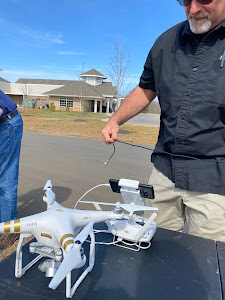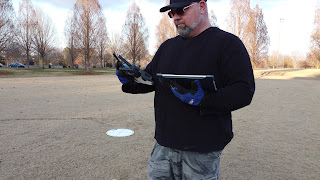10 Essential Tips for Flying a Drone Safely and Legally - 008
Ah, the good old days…just a few years ago where you could go online, look at reviews of drones in your price range, click buy, and a few days later a box arrives on your doorstep. A quick start guide glance later, you were up in the air. Unfortunately, in 2023 it’s not that easy. Before we get into the 10 tips we need to bring you up to speed on Remote Identification, or Remote ID, that some call a digital transponder, and others call a tracking device. Now for a little bit of history.


Source: Photo Jason Torgerson, First Choice Home Inspection and Gary Rosson, EarthView Drone Photography. Photo Credit, TC Freeman, RPA
As a result of many airspace violations, security concerns, etc. we now have Remote Identification, a.k.a. Remote ID, a tracking device (transponder) that’s mandated by Federal Aviation Administration (FAA) regulation. As of late 2022 manufactures were required to include Remote ID in new drones (noticed I said, “were required,” as they are now operating under a grace period of non-enforcement). Existing drone owners with older (non-compliant) aircraft have until September 2023 to purchase an add-on Remote ID module. Currently the only FAA approved module costs $300, ouch! However, there are less expensive options in the works. If there is a bright spot, recreational drone pilots can swap the module between aircraft.
There are two paths of least resistance for recreational flyers to legally not equip with Remote ID. One is to fly drones that weigh under 250 grams as no Remote ID is required (commercial drone pilots are required to equip). The second option is to fly only in designated areas, think RC Parks, called FAA Recognized Identification Areas (FRIA). Now that the history and details of Remote ID has been covered, here are the 10 Tips to Safely and Legally Fly your Drone you have been patiently waiting for.
1. Take the FAA TRUST test online, it’s FREE and required for recreational drone pilots. TRUST covers basic safety information that serves as a practical basis for safety. The good news is that commercial drone pilots, certified as FAA Remote Pilots, can also take the TRUST test and fly recreational when not working as a Remote Pilot. Print off the certificate and keep it “on your person” while flying.
2. Register your drone(s) on the FAA Drone Zone, it’s required for every drone that weighs more that 250 grams and all drones operated commercially. The cost for your entire fleet (recreational pilots only) is $5. A registration number is required to be placed on the exterior of the drone and information about your drones Remote ID has its own field on your page.
3. While hotly contested by some experts in the drone community as to legality, check to see if the State you operate has their own permit. If you plan on taking your drone out of your home State, be sure to search for requirements of State you are planning to visit.
4. Get permission from the property owner if you plan on flying from property that you don’t own. Caution: In addition to States, many cities, colleges/universities, town parks, have enacted their own drone rules. Unfortunately, this has make it difficult for the drone pilot trying to do the right thing because there isn’t a central area for this information about restrictions. The best suggestion is to search the web and look for physical signs on site.
5. Learn to fly your drone safely by taking drone flying lessons from an experienced pilot or watching plenty of videos online and start with basic maneuvers and build up to more complex flying skills. Regardless, be sure to pick an open area free of people and obstacles on a clear day with no wind (or very light wind). While we are biased because it’s our business, receiving drone training before purchasing a drone can give you the opportunity to see how popular drone designs fly. Trainer drones have similar software to more sophisticated models.
6. Before purchasing a drone consider what you want to do with a drone; photography, video, racing, build to fly, etc. A major suggestion is to consider not spending a lot of money on your first drone because accidents happen during the learning phase. However, spend enough money to get a modern drone with a few bells and whistles, like stabilization, wind advisories, Geo-fencing (prohibits you flying in no-fly zones) and a decent camera (if photography is your thing). We could go on about this topic, but our main suggestion is to pick one of the top 5 manufacturers starter models. Don’t be fooled by the word “starter model,” as many commercial drone pilots use basic drones for a variety of jobs. Lastly, be sure to check the maximum windspeed tolerance of the drone you are thinking of purchasing.
7. Believe it or not, in the sky there are highways in the sky, called airways, special areas for the military to practice flying, and no-fly zones around sensitive areas (parks, military, government, etc). Download the FAAs B4UFly App (or one of the many private sector options) so you can begin to learn and stay safe around airspace, which the FAA calls the National Airspace System (NAS). The app shows you the airspace you want to fly and highlights no-fly areas in red and caution areas in yellow. However, the App is just a start, we encourage drone pilots to take a deep dive on learning airspace as it’s one of the most common FAA regulation infractions (see our Airspace video course here).
8. Check Temporary Flight Restrictions (TFRs) that can pop-up quickly covering natural disaster areas, major sporting events, and Presidential movements. While the FAAs B4UFly App is a good resource for TFRs, we recommend checking TFRs the night before and immediately prior to your flight.
9. Check weather reports and forecast, starting with your local TV weather. Drone pilots don’t like limited visibility due to fog, clouds, smoke, or haze, high winds/turbulence, thunderstorms, and rain. Be sure to seek out aviation specific weather training to further your learning.
10. Get some experience flying before attempting to fly close to busy air traffic controlled airspace. After gaining many hours of flying time, work with an experienced instructor or drone pilot to learn and practice the process of airspace waiver approval. Waivers can be granted, typically immediately, up to a certain altitude via the FAAs Low Altitude Authorization and Notification Capability (LAANC) App. There are several FAA approved providers that offer LAANC waiver apps.
One of the most important rules is to fly using common sense, which some say isn’t too common today. Be a good neighbor with a drone by flying well away from people, refrain from buzzing, being aware of airspace and other aircraft, especially emergency responders.
If you have other tips and comments please comment below.
TC Freeman is the Chief Instructor for the RemotePilotAssociation.com has a passion for helping those interested in making money with their drone to earn commercial FAA Remote drone Pilot certification in addition to providing flight training.
Join us for our annual JUNE-JULY New Membership “OPEN HOUSE,” a FREE-no obligation bi-weekly webinar where we discuss drone business, certification and re-currency. Email us to RSVP.
#drone, #dronephotography, #dji


Comments
Post a Comment